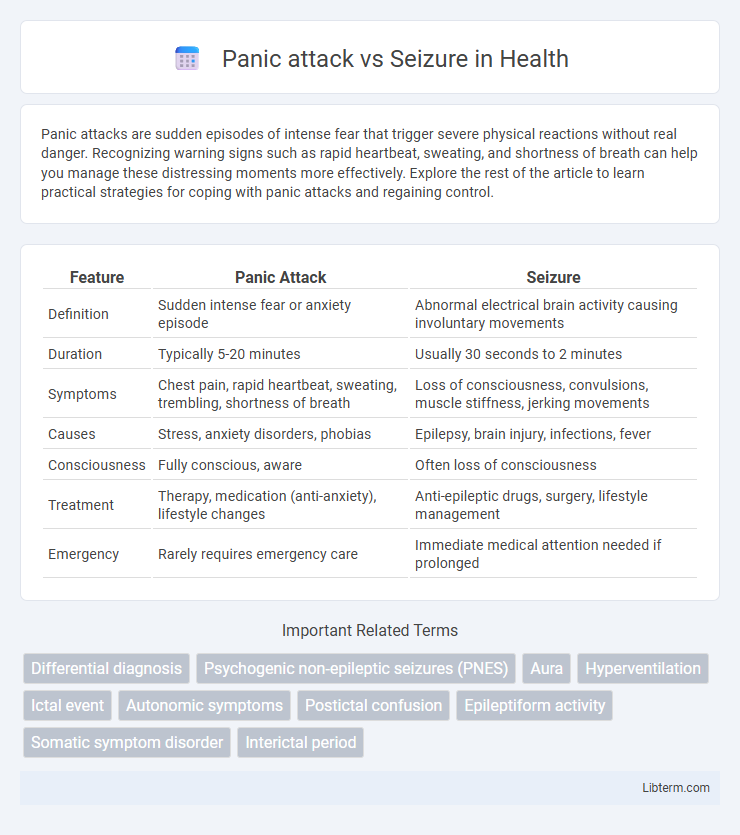Panic attacks are sudden episodes of intense fear that trigger severe physical reactions without real danger. Recognizing warning signs such as rapid heartbeat, sweating, and shortness of breath can help you manage these distressing moments more effectively. Explore the rest of the article to learn practical strategies for coping with panic attacks and regaining control.
Table of Comparison
| Feature | Panic Attack | Seizure |
|---|---|---|
| Definition | Sudden intense fear or anxiety episode | Abnormal electrical brain activity causing involuntary movements |
| Duration | Typically 5-20 minutes | Usually 30 seconds to 2 minutes |
| Symptoms | Chest pain, rapid heartbeat, sweating, trembling, shortness of breath | Loss of consciousness, convulsions, muscle stiffness, jerking movements |
| Causes | Stress, anxiety disorders, phobias | Epilepsy, brain injury, infections, fever |
| Consciousness | Fully conscious, aware | Often loss of consciousness |
| Treatment | Therapy, medication (anti-anxiety), lifestyle changes | Anti-epileptic drugs, surgery, lifestyle management |
| Emergency | Rarely requires emergency care | Immediate medical attention needed if prolonged |
Understanding Panic Attacks and Seizures
Panic attacks involve sudden episodes of intense fear accompanied by physical symptoms such as rapid heartbeat, shortness of breath, and dizziness, often triggered by stress or anxiety. Seizures result from abnormal electrical activity in the brain causing uncontrollable muscle movements, loss of consciousness, or sensory disturbances. Distinguishing between panic attacks and seizures relies on recognizing symptoms like awareness retention in panic attacks versus potential loss of consciousness during seizures.
Key Differences Between Panic Attacks and Seizures
Panic attacks are sudden episodes of intense fear with symptoms like rapid heartbeat, sweating, and shortness of breath, typically lasting minutes without loss of consciousness. Seizures involve abnormal electrical activity in the brain, causing convulsions, muscle rigidity, and potential loss of consciousness, often lasting from seconds to a few minutes. The key difference lies in the neurological basis: panic attacks are psychological events linked to anxiety disorders, whereas seizures are neurological disorders requiring medical evaluation and treatment.
Common Causes of Panic Attacks
Panic attacks commonly arise from intense stress, genetic predisposition, and underlying anxiety disorders, triggering sudden episodes of extreme fear and physical symptoms such as rapid heartbeat and shortness of breath. Unlike seizures, which are caused by abnormal electrical activity in the brain due to epilepsy or neurological disorders, panic attacks stem from psychological and environmental factors including trauma, high caffeine intake, or substance withdrawal. Understanding these distinct causes is crucial for accurate diagnosis and effective treatment strategies.
Triggers and Causes of Seizures
Seizures are caused by abnormal electrical activity in the brain, often triggered by factors such as epilepsy, brain injury, infections, high fever, or metabolic imbalances. Panic attacks, in contrast, stem from psychological triggers like extreme stress, anxiety disorders, or traumatic experiences. Understanding these distinct causes is crucial for accurate diagnosis and targeted treatment strategies in neurological and psychological health care.
Physical Symptoms: Panic Attack vs Seizure
Panic attacks often cause rapid heartbeat, shortness of breath, chest pain, sweating, and trembling, with symptoms peaking within minutes and typically resolving quickly. Seizures manifest as sudden, uncontrolled electrical disturbances in the brain, leading to convulsions, muscle stiffness, loss of consciousness, and sometimes sensory changes or automatisms. Differentiating between panic attacks and seizures relies on recognizing that panic attacks primarily involve intense anxiety-related physical symptoms, while seizures produce distinct neurological signs and altered awareness.
Psychological Symptoms and Experiences
Panic attacks primarily involve intense psychological symptoms such as overwhelming fear, chest tightness, and a sense of impending doom, often accompanied by rapid heartbeat and sweating. Seizures, while sometimes affecting consciousness and behavior, typically lack the prolonged emotional distress seen in panic attacks but may include confusion and uncontrollable muscle movements. Differentiating between these conditions hinges on the presence of acute psychological experiences in panic attacks versus neurological symptoms predominating in seizures.
Diagnosis: How Doctors Distinguish Between Panic Attacks and Seizures
Doctors distinguish between panic attacks and seizures through comprehensive clinical evaluations, including patient history, symptom description, and physical examinations. Electroencephalogram (EEG) tests are crucial for detecting abnormal brain activity characteristic of seizures, while panic attacks typically show normal EEG results. Differential diagnosis may also involve neuroimaging, blood tests, and psychiatric assessments to rule out epilepsy and confirm anxiety-related disorders.
Treatment Options for Panic Attacks
Treatment options for panic attacks primarily include cognitive-behavioral therapy (CBT), which helps individuals identify and manage triggering thoughts and behaviors. Pharmacological treatments such as selective serotonin reuptake inhibitors (SSRIs) and benzodiazepines are also commonly prescribed to reduce the frequency and severity of attacks. Lifestyle modifications like regular exercise, stress management techniques, and avoiding caffeine or alcohol can further support recovery and prevent future episodes.
Medical Management of Seizures
Medical management of seizures primarily involves the use of antiepileptic drugs (AEDs) such as levetiracetam, valproate, and carbamazepine, tailored to the seizure type and patient profile. Continuous monitoring through EEG and neuroimaging supports accurate diagnosis and treatment adjustments to prevent seizure recurrence and reduce severity. Emergency interventions for prolonged seizures may require benzodiazepines like lorazepam, with long-term therapy aiming to balance efficacy and minimize side effects.
When to Seek Emergency Help
Seek emergency help immediately if a seizure lasts longer than five minutes, if the person does not regain consciousness, or if multiple seizures occur without recovery in between. Panic attacks, while intense, rarely require emergency intervention unless accompanied by chest pain, fainting, or difficulty breathing that could indicate a heart attack or other serious medical condition. Always consult emergency services for unexplained or sudden onset symptoms to ensure accurate diagnosis and prompt treatment.
Panic attack Infographic

 libterm.com
libterm.com